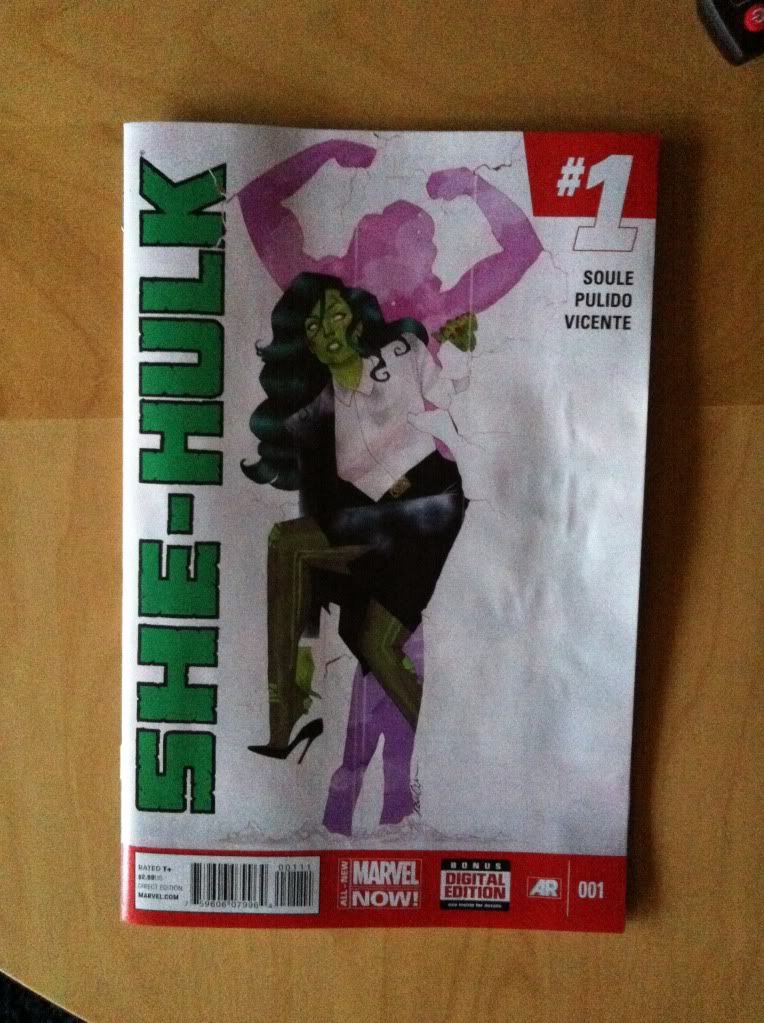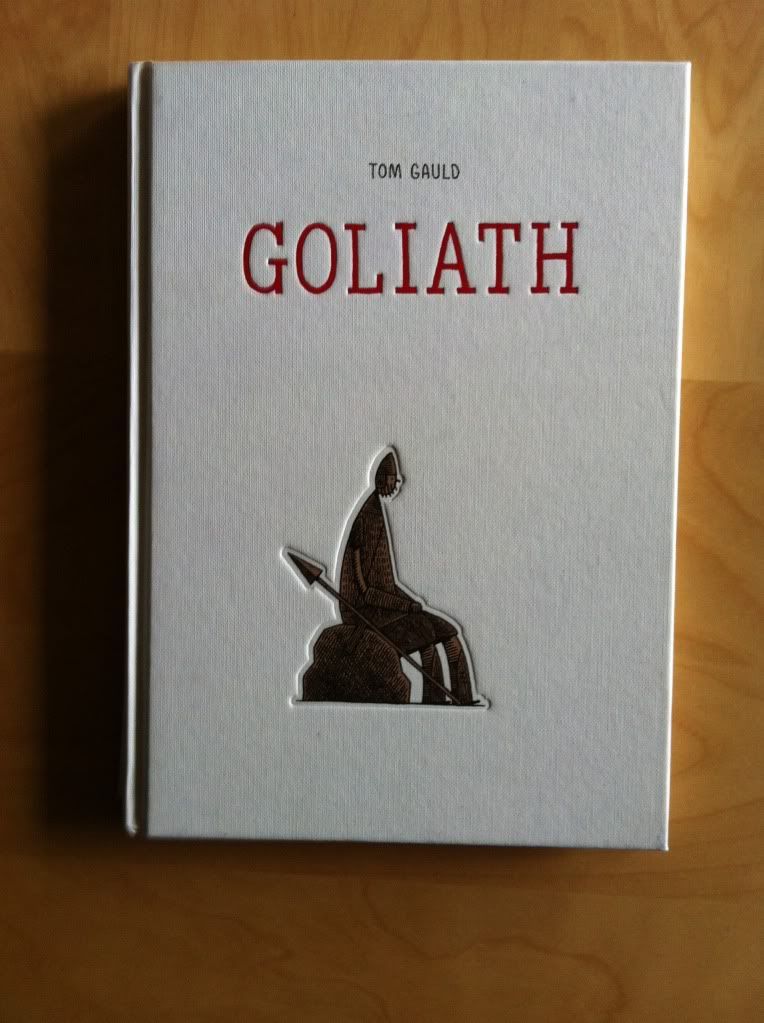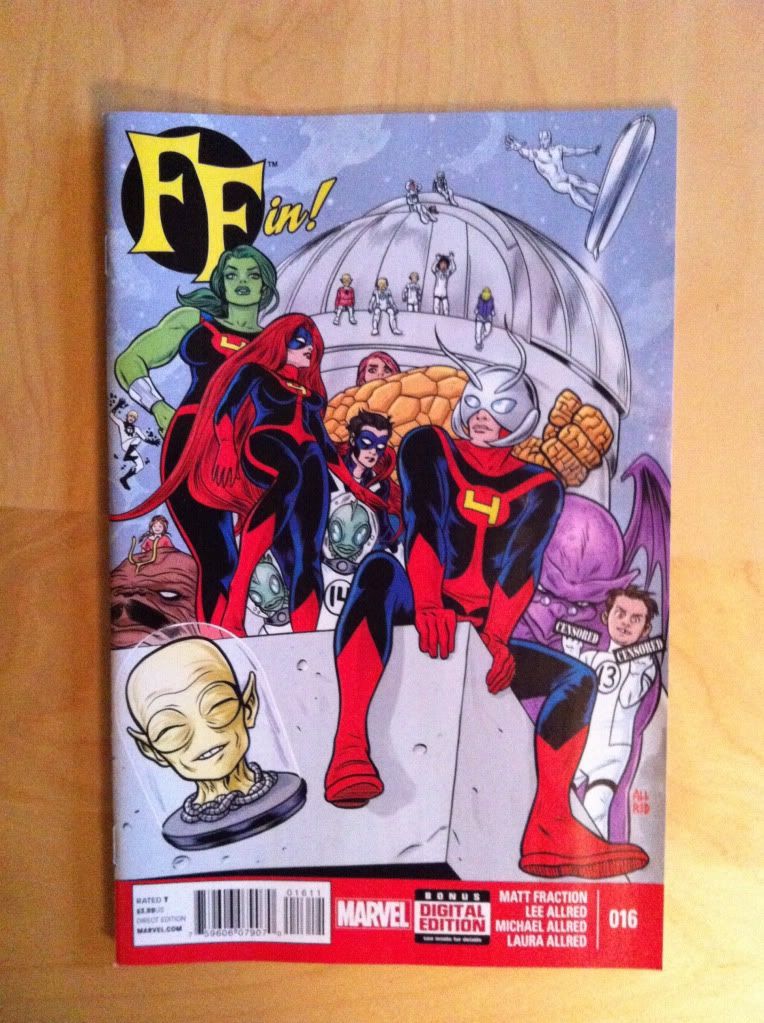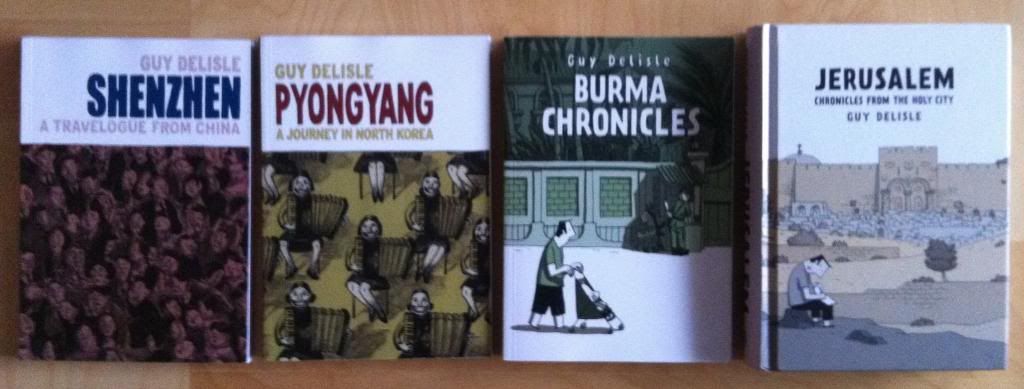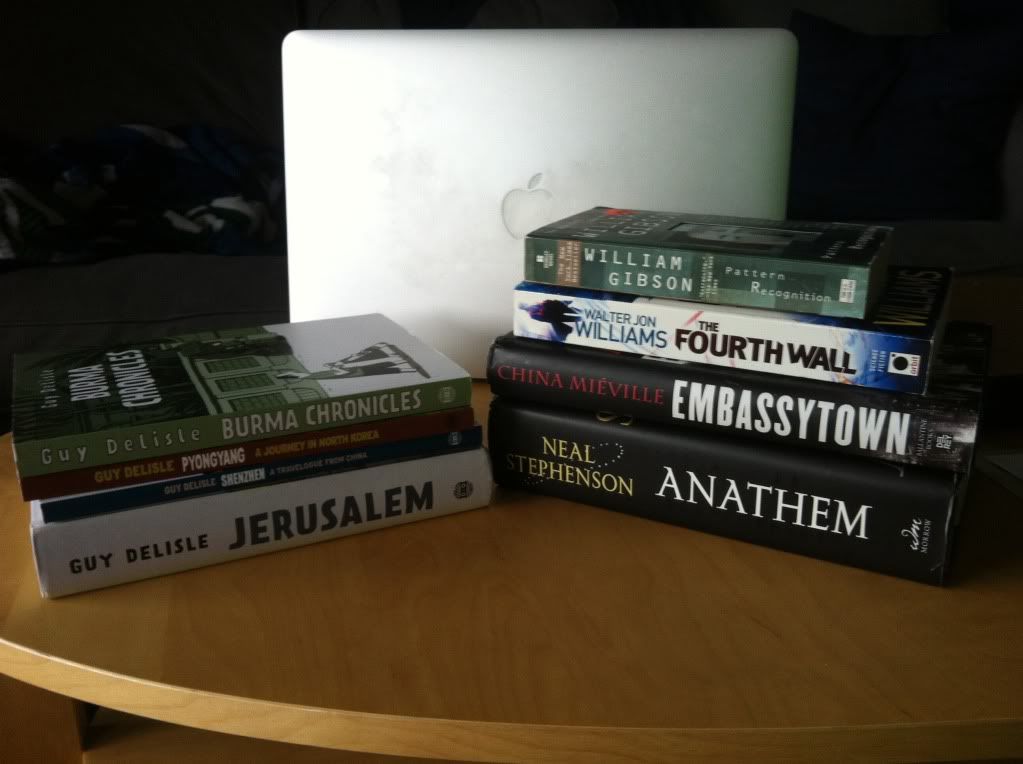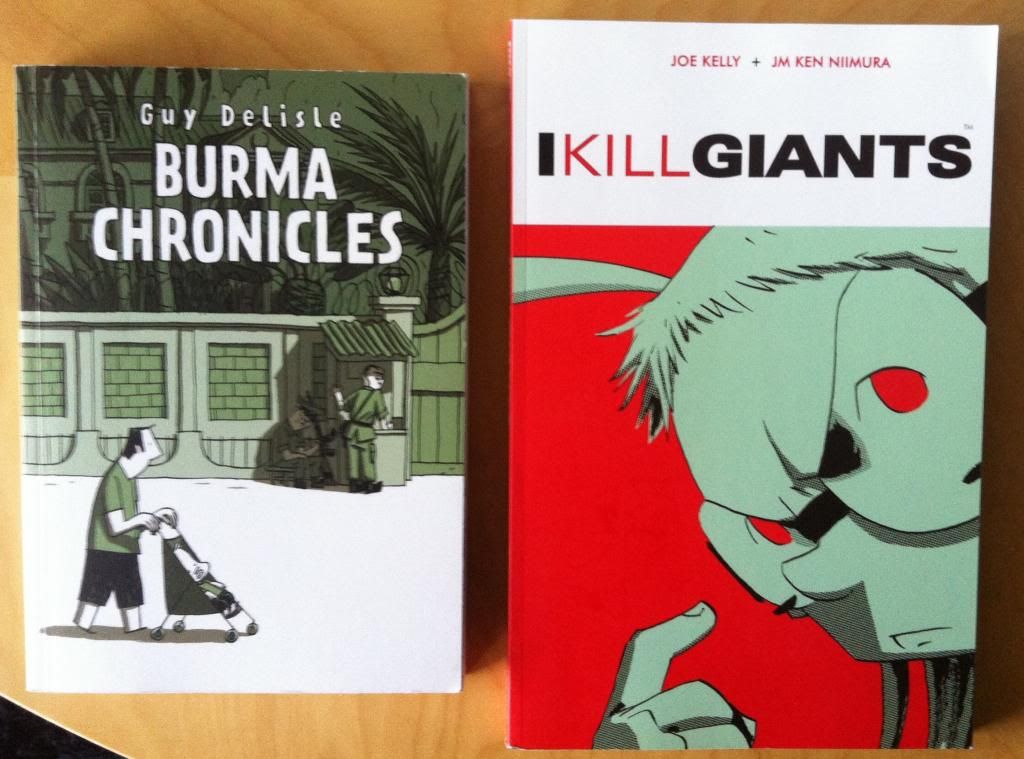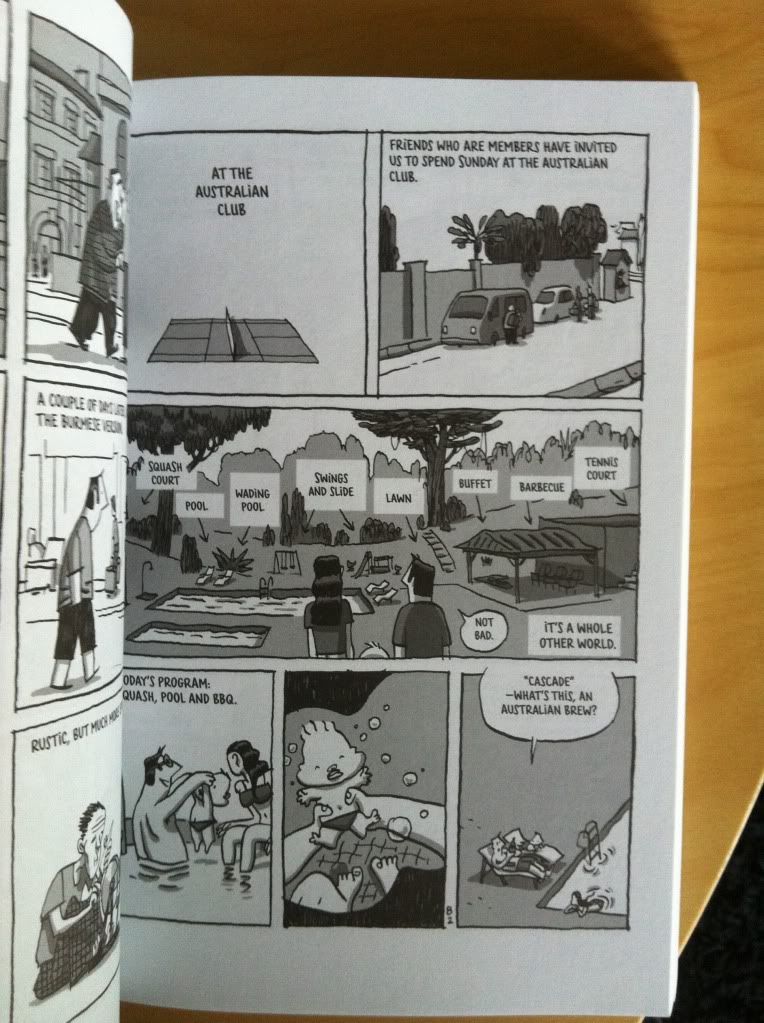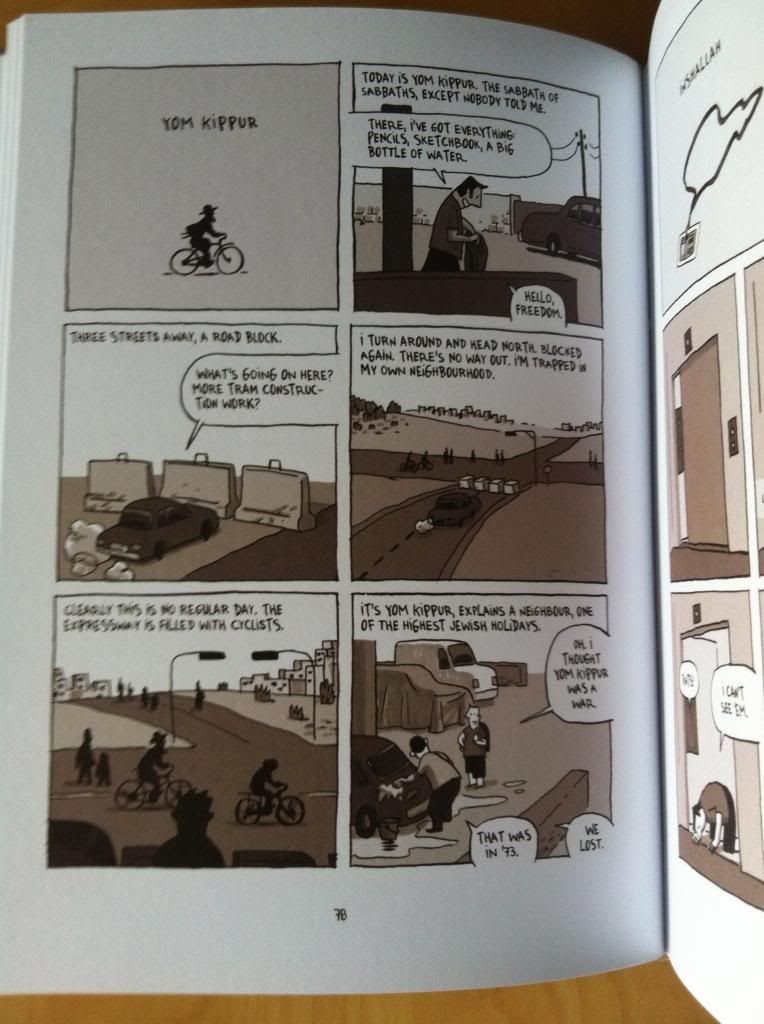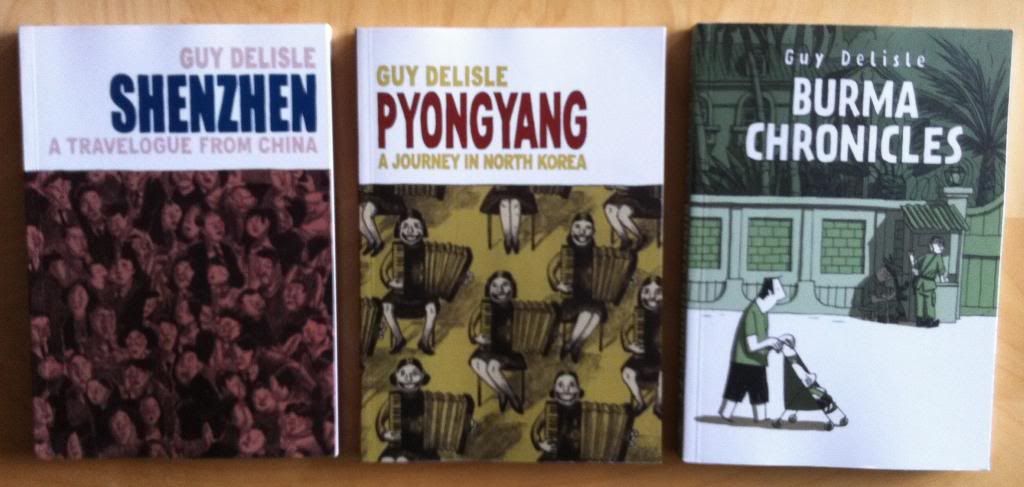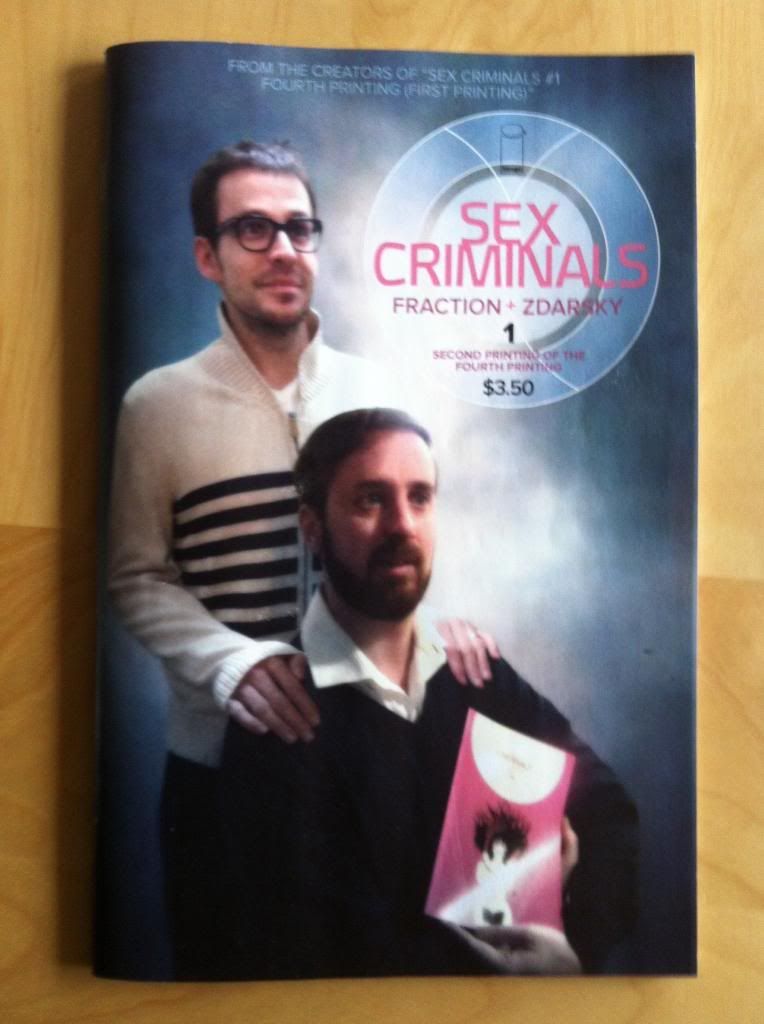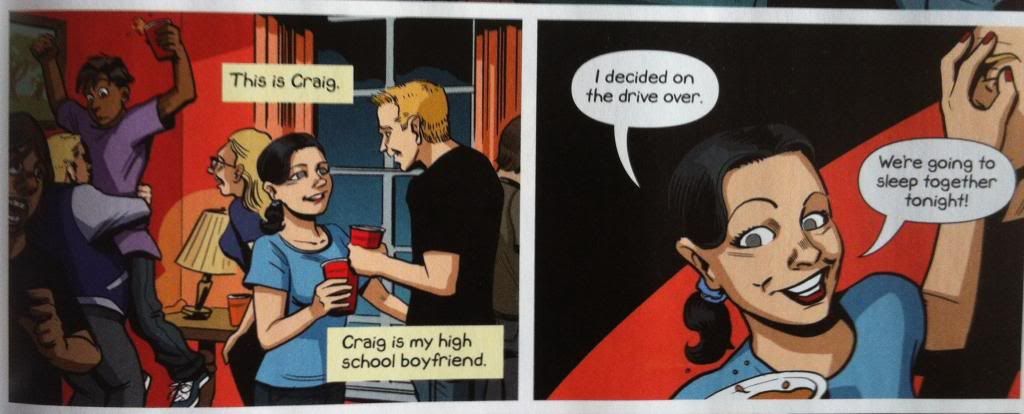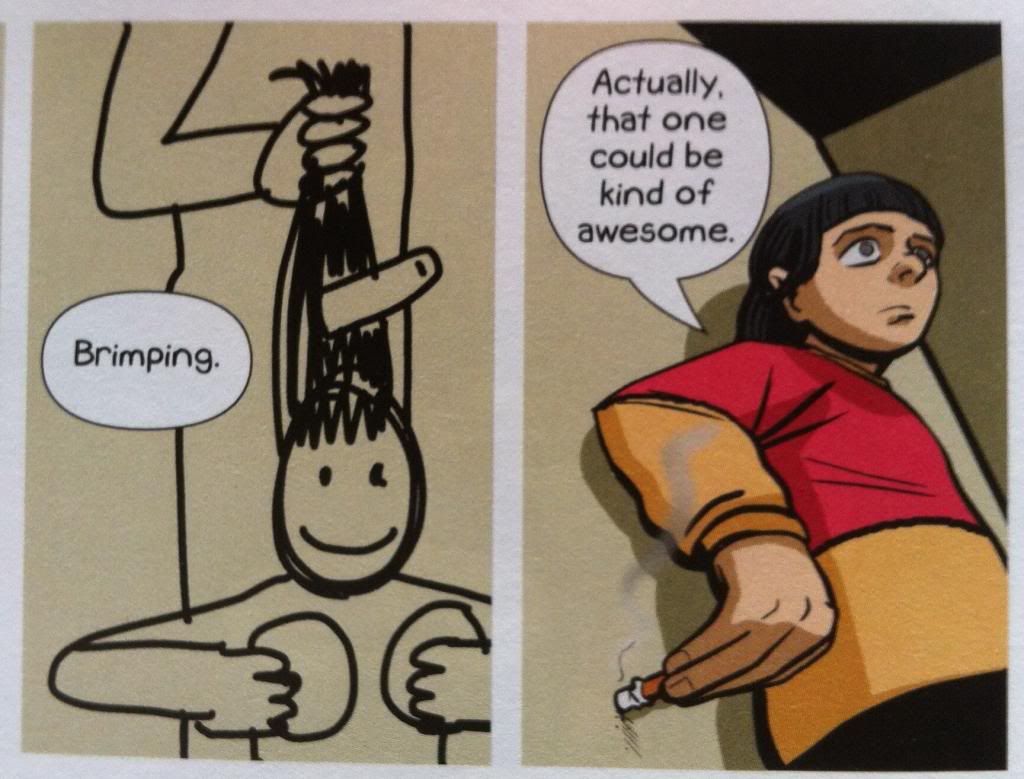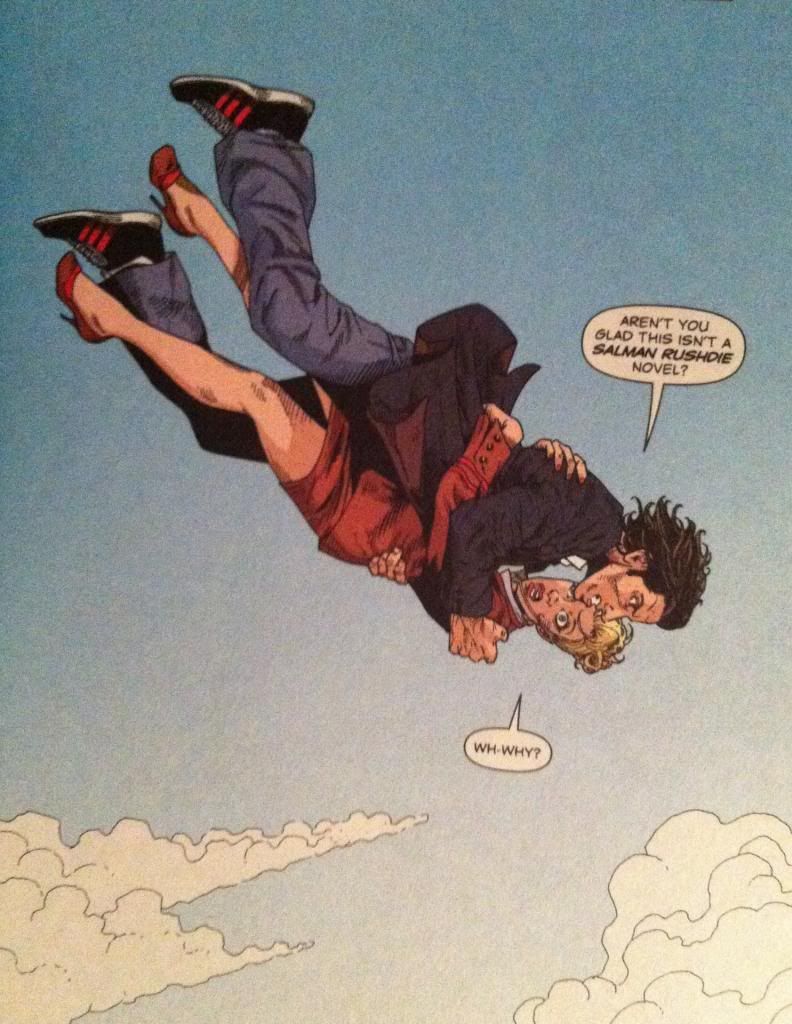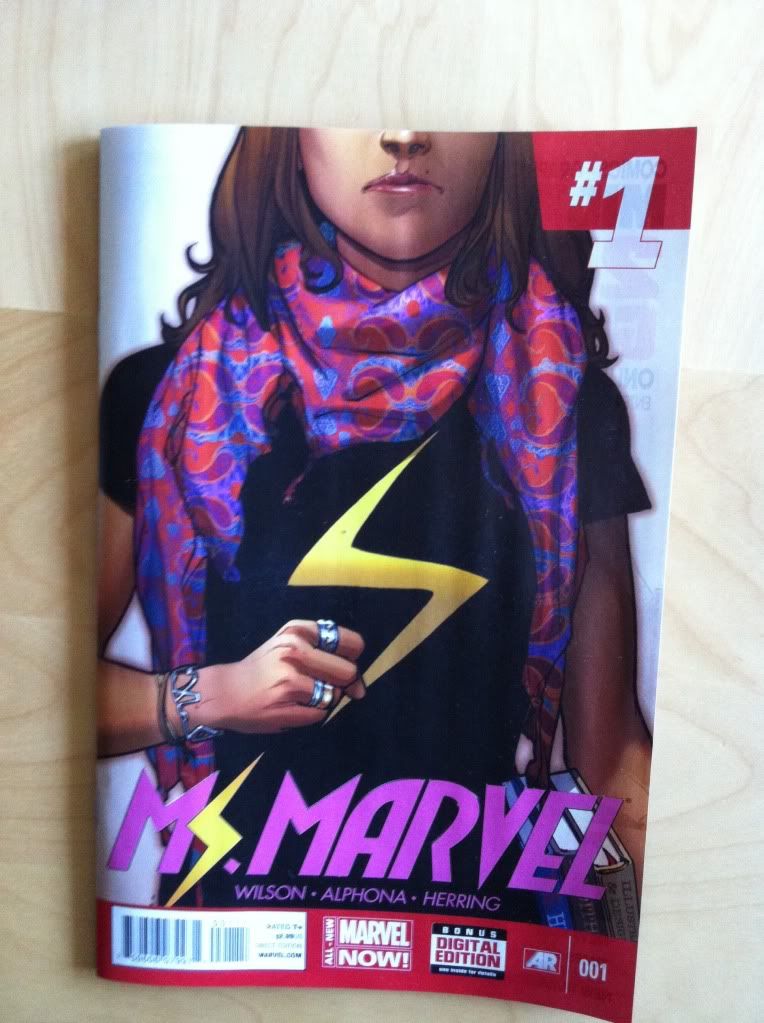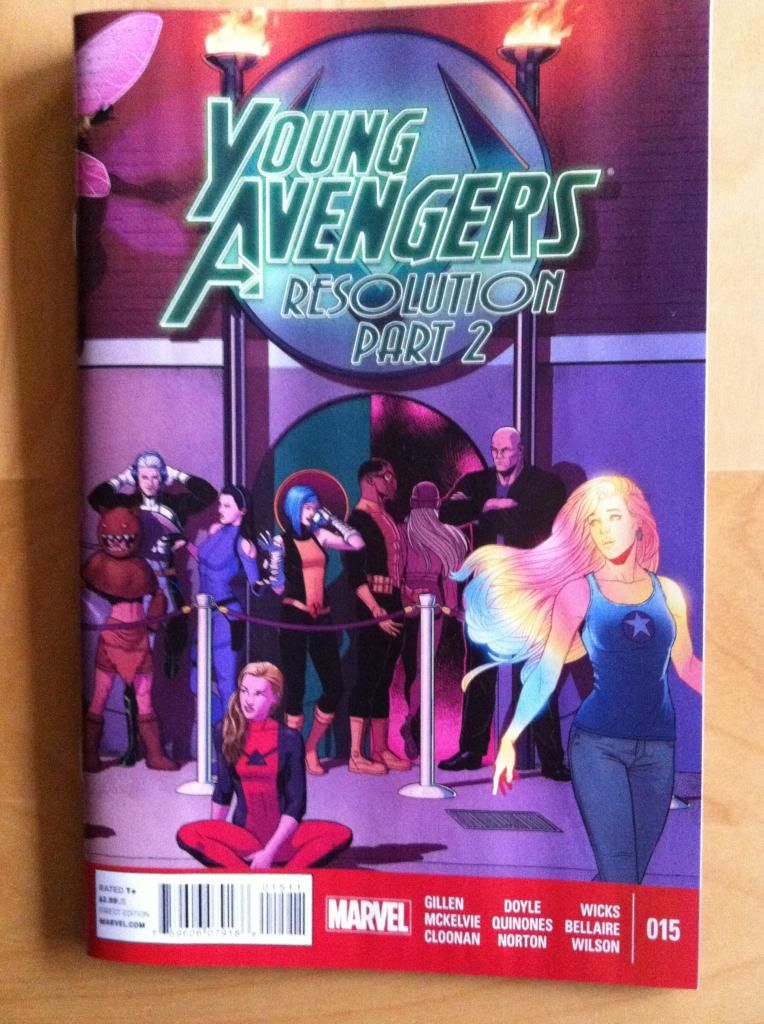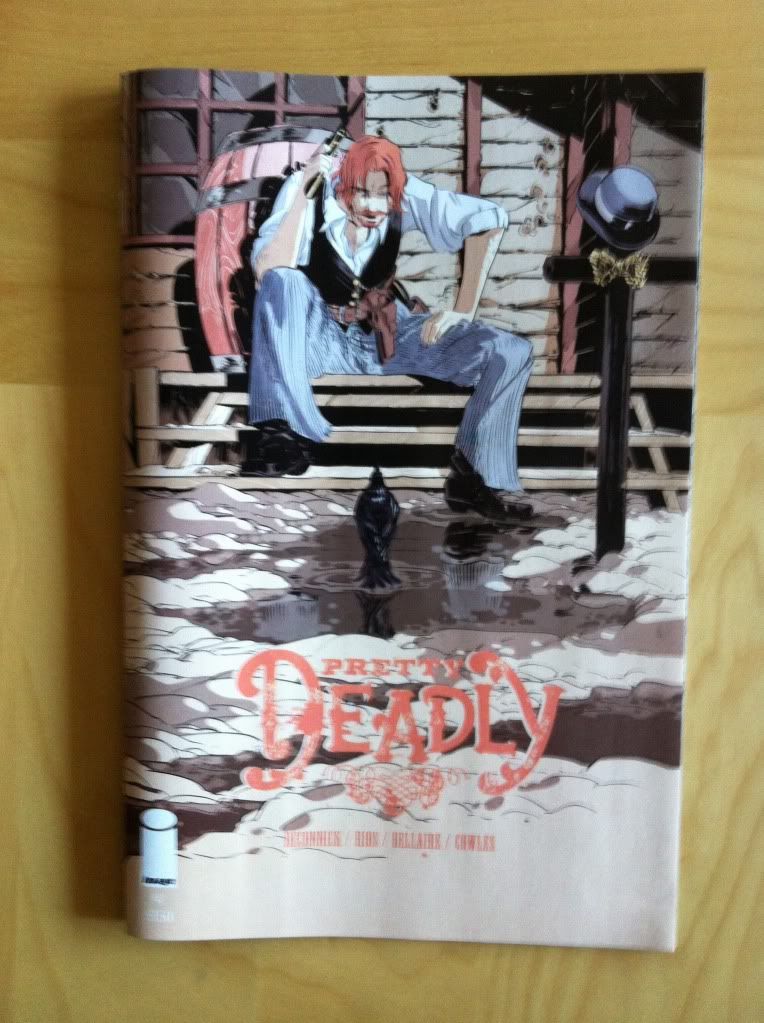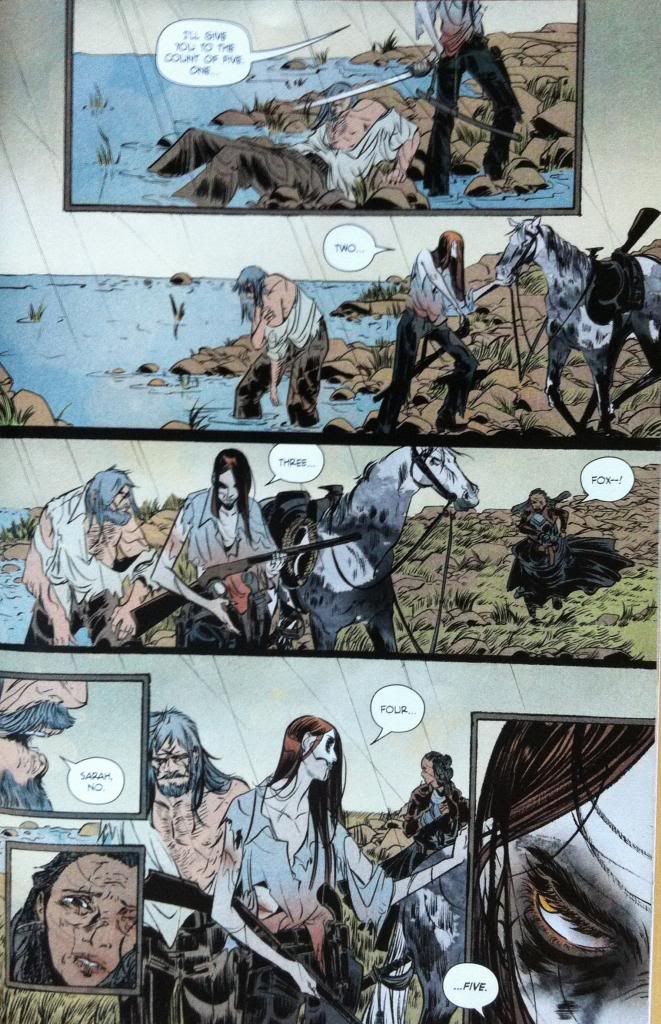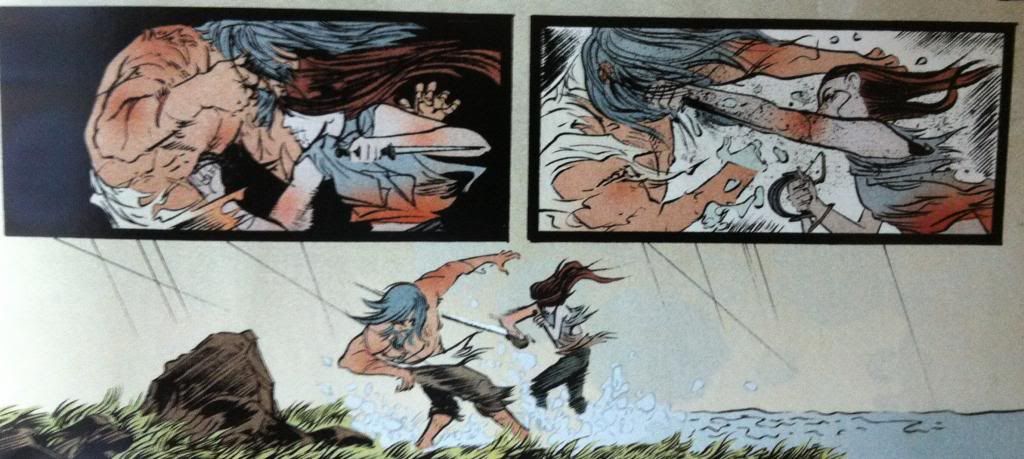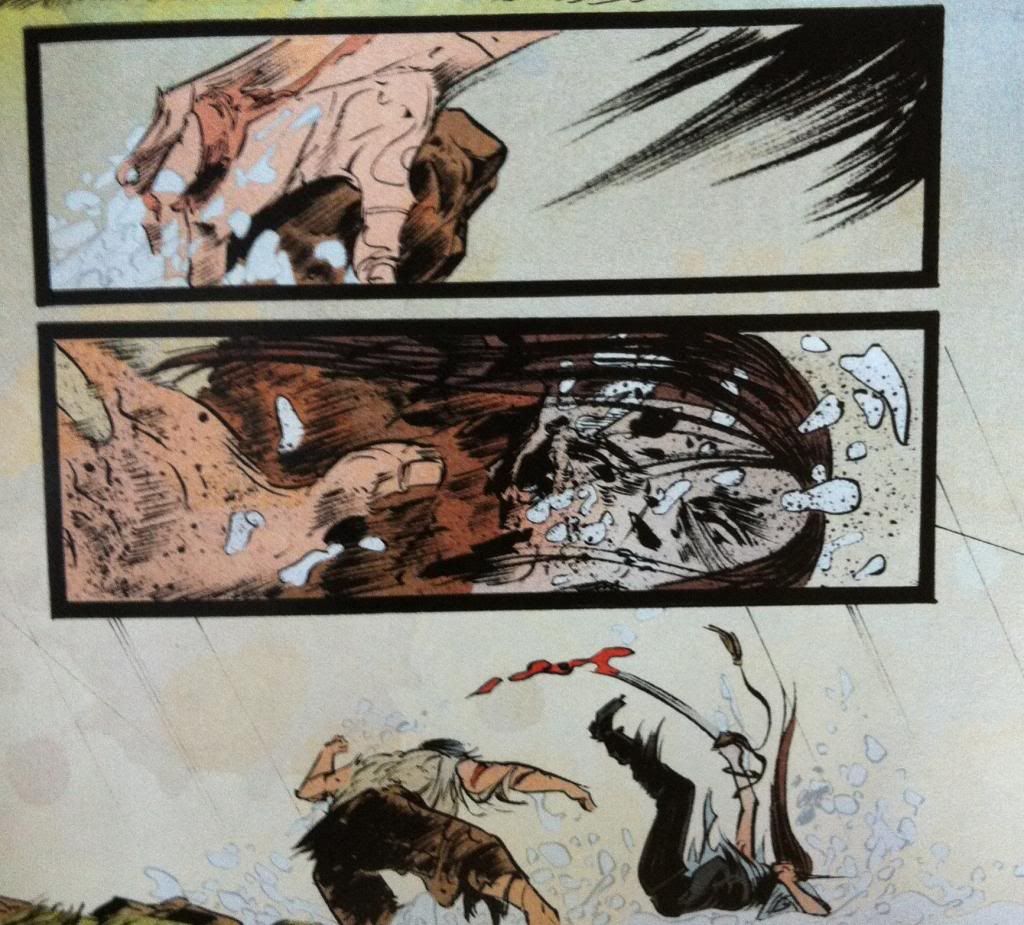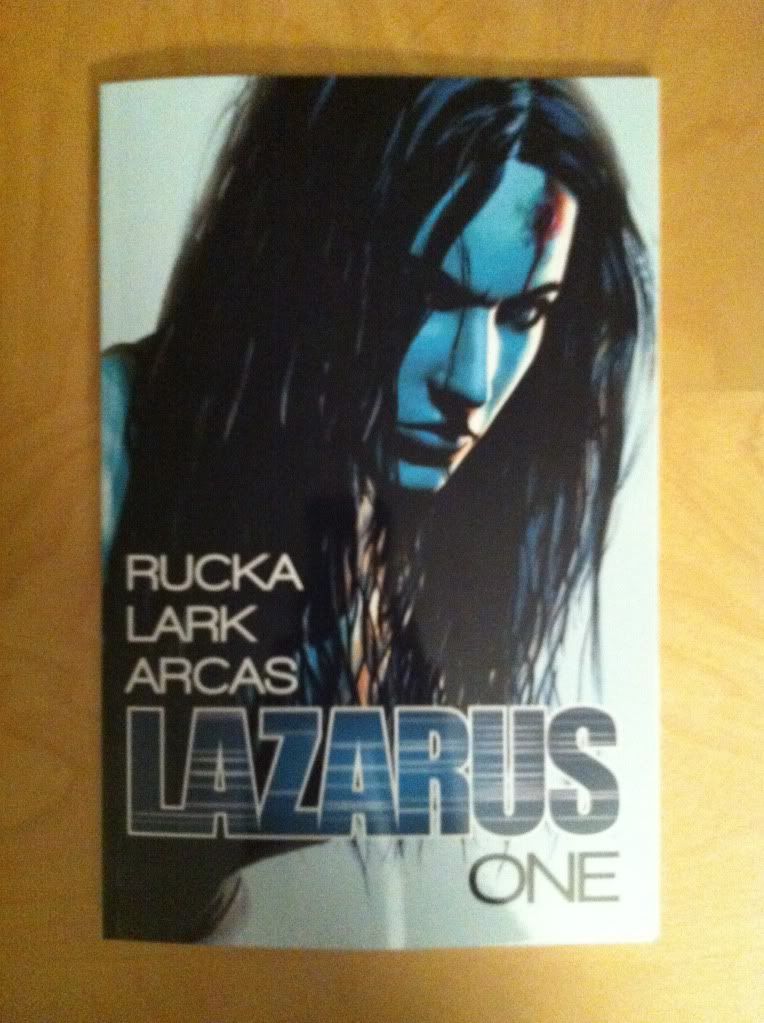Or a look at some really innovative layouts in She-Hulk #1
by Charles Soule, Javier Pulido, Munsta Vicente; Marvel Comics
I really enjoyed She-Hulk #1. The hook of She-Hulk being the star of a law procedural with a light, comedic-ish air, while not completely original, is always good fun and Charles Soule, with his perspective as a practicing lawyer, really portrays the practice of law in an interesting and nuanced way in She-Hulk #1. It's a really fun comic.
She-Hulk #1 is also a really great looking, and technically interesting comic with some absolutely dynamite layouts by Javier Pulido paired with some fantastic colouring by Munsta Vicente. I'm going to take a closer look at a couple of my favourite layouts.
There will be *SPOILERS* for She-Hulk #1, so don't commit a crime against yourself and read the comic first.
I am absolutely in love with this page: Team Shulkie deliver a really interesting pair of sequences that happen simultaneously. One story on the page is that She-Hulk, having quit her high paying law job hits up the local lawyer bar to unwind with whiskey (as is proper [assuming it is done responsibly]). She-Hulk's story ends in the last panel when a lady suddenly appears and says hello. However, this page has a second story which shows the suddenly-appearing-woman canvassing the lawyer bar with a red folder in the background showing where this woman came from. The way I read the page, I saw the entire She-Hulk story without even noticing the second story of folder-woman, so that I was just as completely surprised by her appearance as She-Hulk. Which is kind of great comics: I experienced the same She-Hulk-self-involvement and then surprise as the protagonist.
Now, admittedly, this might be because I am terrible at reading comics and missed something obvious that everyone else in the world noticed. But, the thing is, I've noticed some design elements that seem designed to trick the reader into only following the She-Hulk story and then doubling back to read folder-lady's tale.
My first pass of this page was governed by She-Hulk. She is the sole character in the foreground and is making a number of interesting, dynamic gestures and motions that change from panel to panel and guide the the reader down the gradual left-to-right line of her positioning. Just by body language and posing there is a rich enough pool of visual information to keep the reader busy and focused on Shulkie. This effect is magnified by the colouring. She-Hulk is coloured her bright, emerald green and is wearing a bright, white blouse, which compared with the drab, cooler colours of the background stands out considerably. Especially, when you account for how BIG the emerald/white colour blocks are compared to the much smaller, broken up colour patches of the people and wall signs in the background. Basically, the colouring of the She-Hulk story is just brighter and bolder and helps keep the reader focused on her story instead of the background.
(And really, the She-Hulk story almost functions without any background since tumblr, bottle, waiters arm, and bar top convey the key setting information in the foreground. Which is a really smart choice if you buy my argument that the artwork is designed to misdirect the reader into paying less attention to the background.)
It was these elements that kept me focusing on She-Hulk and her story on this page and made the appearance of folder-lady such an effective surprise.
Of course, once folder-lady appeared, and I realized she was an important character, I went back through the page and found the whole other story. And many of the same compositional elements used to steer through the foreground are also used to move the reader through the background folder-lady story. Colours highlight the woman's blonder hair and the red of the folder to catch the reader. Similarly the woman's gesture and her relationship to the folder helps make a visual guide that leads the reader through her story so that the folder-lady part of the page ends just as effectively with her looking at She-Hulk. It's a pretty clean, nice little sequence.
And combined, I think, these two layered sequences make this page super interesting. Misdirection keeps the reader focused on She-Hulk and maximizes surprise, and then rewards the reader with a hidden, yet important story of folder-lady failing to find a lawyer. It's really cool, and honestly, how often do you see comics pages designed to be read twice?
This double page spread is also pretty awesome and does some really cool things with panel shape and perspective to emphasize some really interesting elements of the page that makes the drama/comedy of the page work.
The crux of what I love about this spread is the LOOOoooooooonnnnngggg hallway and how the art emphasizes the heck out of this distance to great effect. The composition, with its 18th floor Ding!, takes from the top of the first panel into the top of the second panel. This places us at the end of the hall and then, as we, look down the very tall panel we see, and experience, just how far away She-Hulk is from the end of the hallway. What's even more great about this is Shulkie is on an angle and facing upwards along the hallway which makes the distance loom larger and emphasizes the uphill-climb-challenge of walking down this very long hallway. This leads into the next two panels which show She-Hulk progressing along the hallway, but also walking uphill, continuing to emphasize the gruelling effort of walking down such a long-ass hallway. The composition then doubles back towards the centre of the page where we meet Legal, Tony Starks lawyer. The result of this doubleback is that the reading path takes just about the longest route possible to get from the elevator to Legal which makes us the reader actually experience the length of the hall. It is absolutely an amazing bit of design and layout work.
She-Hulk #1 is a fantastic comic that has me super excited to read more She-Hulk.
Friday, 28 February 2014
Wednesday, 26 February 2014
So I Read Goliath
A 250 word (or less) review of the Goliath graphic novel
By Tom Gauld; Drawn and Quarterly
Sometimes it's fun knowing how the story ends. Goliath is a comic about one of the oldest stories in the Judaeo-Christian tradition. A story that pits a humble shepherd against the fearsome giant Goliath in single combat to decide the fate of a war. A story where the shepherd, graced by righteous power of god, strikes down the giant with nothing but a similarly humble stone thrown from a humble sling. It's a story that tells about underdogs defeating favourites, heroes standing up to bullies, and the power of conviction and courage in the face of adversity. Everyone knows it. But what if that version of the story is completely wrong? What if the narrative we all know is a lie written by the victors or a story mistranslated into allegory by eons? Goliath tells the biblical story from the perspective of Goliath, a pretty okay giant guy in a crumby situation, and the series of misunderstandings that lead to the tales bloody ending. It's a really pensive and bleakly funny comic that strains under the gravitas of its inevitable conclusion. It is drawn in this really expansive, open, minimalist way that is the perfect visual palette for the books themes. The resulting comic is.... arresting. Goliath is certainly a comic worth reading despite already knowing the ending.
Word count: 219
By Tom Gauld; Drawn and Quarterly
Sometimes it's fun knowing how the story ends. Goliath is a comic about one of the oldest stories in the Judaeo-Christian tradition. A story that pits a humble shepherd against the fearsome giant Goliath in single combat to decide the fate of a war. A story where the shepherd, graced by righteous power of god, strikes down the giant with nothing but a similarly humble stone thrown from a humble sling. It's a story that tells about underdogs defeating favourites, heroes standing up to bullies, and the power of conviction and courage in the face of adversity. Everyone knows it. But what if that version of the story is completely wrong? What if the narrative we all know is a lie written by the victors or a story mistranslated into allegory by eons? Goliath tells the biblical story from the perspective of Goliath, a pretty okay giant guy in a crumby situation, and the series of misunderstandings that lead to the tales bloody ending. It's a really pensive and bleakly funny comic that strains under the gravitas of its inevitable conclusion. It is drawn in this really expansive, open, minimalist way that is the perfect visual palette for the books themes. The resulting comic is.... arresting. Goliath is certainly a comic worth reading despite already knowing the ending.
Word count: 219
Monday, 24 February 2014
Atoll Comics Round 12
Or changes to my top-ten comics
Due to poverty and an urge to buy better comics, I have decided to be super-selective about which superhero comics I read. Harnessing the Awesome Power of Maths, I have determined that I can afford to read 10 ongoing titles. So I get to read 10, and only 10, titles published by either Marvel or DC as well as one trade paperback a week of my choosing.
Due to poverty and an urge to buy better comics, I have decided to be super-selective about which superhero comics I read. Harnessing the Awesome Power of Maths, I have determined that I can afford to read 10 ongoing titles. So I get to read 10, and only 10, titles published by either Marvel or DC as well as one trade paperback a week of my choosing.
A complication of this is that I am forced to drop an on-going title if I want to try reading a new on-going title, an act of very tough love. Being financially responsible is the worst.
I will be adding She-Hulk and dropping FF.
Why She-Hulk: She-Hulk is absolutely the kind of comic I want to read from mainstream Marvel. It's fun, has an interesting narrative angle (lawyer She-Hulk fixing problems she can't punchout), and is absolutely beautiful with just masterful artwork by Javier Pulido. It's great!
Actually, I think the magic of She-Hulk goes beyond quirk and execution. I'm a career academic who TA's to supplement my income which means I spend a lot of time trying to figure out when people have no idea what they are talking about. So I'd like to think I'm developing a sense for when people are experts or trying to fake it. And the thing is She-Hulk is a comic that is being written by Charles Soule who is an actual, real life lawyer and his expertise really shines through. The result is a comic that feels authentic and nuanced and interesting. While, you know, still being fun and charming and funny.
And that's not even getting to the art team of Javier Pulido and Muntsa Vicente. She-Hulk is a comic that visually is basically perfect. Javier Pulido has a gorgeous clean style, amazing character acting chops, and just endlessly fascinating approaches to layout that make even the most legal-proceeding heavy sequences interesting to look at. Muntsa Vicente, meanwhile, is the perfect colourist with a bright, pop-arty, flat colouring style that is the perfect partner for Pulido's lineart. She-Hulk is a comic with the kind of art that is worth the price of admission.
If you like my taste in comics, especially those in my top-ten mainstream books, than the first issue of She-Hulk is pretty much a must read. If it is any indication of the kind of book the whole series will be, than it will absolutely be a top-ten comic.
Why not FF: FF is another great comic that has ended. For being a comic I almost didn't buy into, largely because I was so happy with Hickman's FF, I ended up really enjoying the Fraction/Allreds version. This FF wasn't the high concept Sci-fi book that emphasized the weird nature of child genius, but was instead, at its best, a book about a bunch of kooky comic book kids being fun. FF was like this joyful celebration of everything that is great about comics that was also a really well made comic. But like most really great and original mainstream comics, it has an ending and that means it's time to say goodbye and replace it in my Pull List.
Previously:
Atoll Comics Round 8: The Indestructible Hulk and FF in and Uncanny Avengers out
Atoll Comics Round 7: Young Avengers in and Winter Solider out
Atoll Comics Round 6: Either The Indestructible Hulk or FF in and Batwoman out
Atoll Comics Round 5: Avengers in and Fantastic Four/FF out
Atoll Comics Round 4: Avengers Assemble in and The Invincible Ironman out
Atoll Comics Round 3: Uncanny Avengers in and Ultimate Spider-Man out
Atoll Comics Round 2: Hawkeye in and The Flash out
Atoll Comics Round 1: Captain Marvel in and Thunderbots/Dark Avengers out
Atoll Comics Round 0: The originals
Atoll Comics Round 7: Young Avengers in and Winter Solider out
Atoll Comics Round 6: Either The Indestructible Hulk or FF in and Batwoman out
Atoll Comics Round 5: Avengers in and Fantastic Four/FF out
Atoll Comics Round 4: Avengers Assemble in and The Invincible Ironman out
Atoll Comics Round 3: Uncanny Avengers in and Ultimate Spider-Man out
Atoll Comics Round 2: Hawkeye in and The Flash out
Atoll Comics Round 1: Captain Marvel in and Thunderbots/Dark Avengers out
Atoll Comics Round 0: The originals
Friday, 21 February 2014
Deep Sequencing: Travelling Travelogue
Or a look at why Guy Delisle's travelogue comics make perfect travel companions
I'm the kind of person who fills up a giant backpack with books and comics whenever international travel happens for time spent on airplanes, in transport, laying on beaches, and especially when I travel alone for work. Reading makes the time stuck in a too-small seat slightly less awful when in the air or on rails and makes time killed in a pub alone more socially acceptable! And whats better than laying on a beach with a cold beverage and an excellent book or comic? Few things!
But travel reading comes with a series of special challenges. Challenges which I think the travelogue comics of Guy Delisle perfectly address.
The first challenge is space: whenever travelling involves baggage there is only so much stuff you can pack and since I am a luddite who prefers his reading material to come in dead tree form, this means there is a limit on the number of books and comics I can pack. Guy Delisle's travelogues, while still being a substantial length, are comics that are thinner than a novel. While it's true novels are a denser entertainment medium, if you want a good amount of comic that won't monopolize travel space, these travelogues are about the right size.
The second travel reading challenge is also space: when you are exploring a new city or trying to find the perfect place on the beach it's nice to use a smaller rucksack to carry your water bottles (filter equipped), guidebooks, maps, and other travelling stuff. The cost of this smaller backpack is that tradepaperback sized comics don't fit into the bag. Conveniently, Guy Delisle travelogues, with their novel-like dimensions, will fit right into a small rucksack.
One of the other challenges specific to comics is content. I once tried to read Black Hole on an airplane (before I appreciated how twisted and pornographic a comic it is). It was... a non-starter. Reading on an airplane or in other public places, I think, requires a certain level of consideration for the sensibilities of the people around you. While you can read a filthy novel, like Crooked Little Vein, anywhere without upsetting the people around you, comics are a visual medium which can mean objectionable pictures which means that I think you should choose a comic that you can read in front of children and the elderly without offending people when travelling. Guy Delisle's comics are about life in other places delivered with slapstick humour and is at worst PG13. It's safe for work and travel.
(Also there are some weird laws about what constitutes obscenity or pornography in other countries, and some countries reserve the right to rifle through your books and hard drives. As such, it might actually be wise and not just polite to show some discretion with which comics you bring travelling with you. By all means, read whatever filthy thing you want at home, but maybe choose something like Jerusalem or Burma instead of Black Kiss when abroad.)
When it comes to comics you read while actually getting around the place your visiting the Delisle comics are also a pretty great choice. When it comes to rides on subways or trains into city centres, reading opportunities come in little bursts where you need to quickly quit your reading and rush off to explore and what-not. Since I hate stopping a thing in the middle of a section (chapter, section, whatever), comics and books with short chapters or frequent page breaks are pretty great for travelling. And the Delisle comics are great in that they are broken up into individual strips that usually run a page or two, with the occasional single narrative stream running up to ten pages. It's a way of doing comics where there is always a convenient jumping off spot just a page away.
Then there is the actual subject matter. Guy Delisle's travelogue comics are travelogues: they document prolonged stays in Jerusalem, Burma, Shenzhen and Pyongyang with an eye for the small particulars of life as well as the broader society and social injustice. And what could more perfect to read while travelling than comics about other places? It's like a comics vacation WITHIN a larger vacation. Which, I think, more than the convenient format size, public space appropriate content, and short chapters is what makes Guy Delisle's comics perfect for vacations.
I'm the kind of person who fills up a giant backpack with books and comics whenever international travel happens for time spent on airplanes, in transport, laying on beaches, and especially when I travel alone for work. Reading makes the time stuck in a too-small seat slightly less awful when in the air or on rails and makes time killed in a pub alone more socially acceptable! And whats better than laying on a beach with a cold beverage and an excellent book or comic? Few things!
But travel reading comes with a series of special challenges. Challenges which I think the travelogue comics of Guy Delisle perfectly address.
The first challenge is space: whenever travelling involves baggage there is only so much stuff you can pack and since I am a luddite who prefers his reading material to come in dead tree form, this means there is a limit on the number of books and comics I can pack. Guy Delisle's travelogues, while still being a substantial length, are comics that are thinner than a novel. While it's true novels are a denser entertainment medium, if you want a good amount of comic that won't monopolize travel space, these travelogues are about the right size.
The second travel reading challenge is also space: when you are exploring a new city or trying to find the perfect place on the beach it's nice to use a smaller rucksack to carry your water bottles (filter equipped), guidebooks, maps, and other travelling stuff. The cost of this smaller backpack is that tradepaperback sized comics don't fit into the bag. Conveniently, Guy Delisle travelogues, with their novel-like dimensions, will fit right into a small rucksack.
(Also there are some weird laws about what constitutes obscenity or pornography in other countries, and some countries reserve the right to rifle through your books and hard drives. As such, it might actually be wise and not just polite to show some discretion with which comics you bring travelling with you. By all means, read whatever filthy thing you want at home, but maybe choose something like Jerusalem or Burma instead of Black Kiss when abroad.)
When it comes to comics you read while actually getting around the place your visiting the Delisle comics are also a pretty great choice. When it comes to rides on subways or trains into city centres, reading opportunities come in little bursts where you need to quickly quit your reading and rush off to explore and what-not. Since I hate stopping a thing in the middle of a section (chapter, section, whatever), comics and books with short chapters or frequent page breaks are pretty great for travelling. And the Delisle comics are great in that they are broken up into individual strips that usually run a page or two, with the occasional single narrative stream running up to ten pages. It's a way of doing comics where there is always a convenient jumping off spot just a page away.
Then there is the actual subject matter. Guy Delisle's travelogue comics are travelogues: they document prolonged stays in Jerusalem, Burma, Shenzhen and Pyongyang with an eye for the small particulars of life as well as the broader society and social injustice. And what could more perfect to read while travelling than comics about other places? It's like a comics vacation WITHIN a larger vacation. Which, I think, more than the convenient format size, public space appropriate content, and short chapters is what makes Guy Delisle's comics perfect for vacations.
Wednesday, 19 February 2014
So I Read Pyongyang, Shenzhen, and Burma Chronicles
A 250 word (or less) review of the travellogue comics of Guy Delisle
Guy Delisle; Drawn and Quarterly (English Editions)
Word count: 248
Previously:
Jerusalem: Tales from the Holy City
Guy Delisle; Drawn and Quarterly (English Editions)
Sometimes
it is easy to forget how great it is to live in a reasonably free country with
a judiciary and rule of law and a million other taken for granted things. It
can be easy to forget that millions or even billions of people live in places
where safety or poverty or injustice are endemic. And when we do think of these
people we can just as easily forget that they ARE people and that their
cultures and homes can be just as beautiful as they are tragic. Guy Delisle's
travelogue comics offer a really interesting and fair look into some of the
more marginalized places on Earth. In Shenzhen, Deslisle takes us into the
walled Chinese factory city where all of our stuff is made as he works with
Chinese animators. Similarly, In Pyongyang we journey with Deslisle on another
French animation project into the secretive and elaborately bizarre world of
North Korea. In Burma Deslisle and his Medicens Sans Frontiers partner travel
to Burma, a country that was tightly shuttered by a ruthless and strange
Military Junta. In these comics we get to see life inside these
locales as Deslisle embeds himself into the fabric of these societies. We get
to see his day-to-day routine and meet a variety of locals, but also tackle
some of the larger issues that isolate these locations. It’s a wonderful
blending of slice-of-life comic autobiography and hard-hitting journalism.
These comics are also, for my money, the best travel companions.
Word count: 248
Previously:
Jerusalem: Tales from the Holy City
Monday, 17 February 2014
Investigating Sex Crminals #1: The Reprint Of The Fourth Printing
A look at some of the nifty colouring in Sex Criminals #1
by Matt Fraction and Chip Zdarsky, Image Comics
I have a few rules about buying comics. Rule 1: Have a limit on the number of comics I buy in issues (my top-ten ongoing titles). Rule 2: Focus on creator owned stuff by by tradewaiting and buying one tradepaperback or graphic novel format comic a week. Rule 3: Never, ever, ever buy an issue of a comic for a gimicky cover. Never.
Well, Sex Criminals #1, the reprint of the fourth printing, has made me break all these rules. Congratulations Misters Fraction and Zdarsky (IF THOSE ARE YOUR REAL NAMES!) for making me a giant money wasting hypocrite. (The comic was really good, and uh, the cover is super fun.)
Anyway, I was inspired by the cover so this happened:
(I was trying to get something more all in a row, but Marls was NOT HAVING IT. So we compromised.)
I'm late to the Sex Criminals Party, since I was previously doing my best to tradewait for the first collection. Alas I could only delay gratification for so long and caved to a pair of pretty faces. I was just too excited. What can I say about the comic that hasn't already been said in a more timely fashion? It's a pretty great comic that manages to be pretty funny, wildly juvenile, and surprisingly heartfelt. And by trying to tackle the idea of sex in a humorous and honest way it manages to be something kind of special and maybe unique in todays comics scene. Oh yeah, it's also a comic where two people can stop time by having orgasms and decide to use the power to rob a bank. So it's probably worth a look.
Sex Criminals is also a comic that makes some really clever and effective use of colouring.
There will be *SPOILERS* for Sex Criminals #1 below.
A thing I noticed about the colouring in Sex Crimnals is how much it plays with contrasting, complimentary colours to make Suzie just pop out. By having a green shirted kid Suzie in the mostly Red bathroom or teenage Suzie in her blue tshirt in the orangey-red party, the colours contrast in just the right way to make her pop out in a really simple way that just looks really nice. It's smart and fun.
And then there is this page. The way this page uses red to guide the eye through a pretty complicated page is really smart and great. This time the knack of it is that red is bright and eye catching, so our eyes are naturally drawn to the cherry red of Suzie's shirt and the shoulders of Jon's shirt. Couple that with a background that has a grey, shawdowy muted quality, and there is basically a red guideline that runs in a zig-ag from the top left corner to the bottom right corner. Basically, this lets the reader easily navigate the space and focus on the key characters while still having a rich, crowded background filled with party goers. It also, by so clearly demarcating Suzie and Jon as the focus of the page, creates the emotion of the moment of meeting the perfect person at a party and having the rest of the world just kind of fall away. This is a really smart page that is a great example of how thoughtful colouring can just make comics work better.
So yeah, Sex Criminals is a fun, interesting comic with some really smart compositional elements amongst all of the funny dick jokes.
by Matt Fraction and Chip Zdarsky, Image Comics
I have a few rules about buying comics. Rule 1: Have a limit on the number of comics I buy in issues (my top-ten ongoing titles). Rule 2: Focus on creator owned stuff by by tradewaiting and buying one tradepaperback or graphic novel format comic a week. Rule 3: Never, ever, ever buy an issue of a comic for a gimicky cover. Never.
Well, Sex Criminals #1, the reprint of the fourth printing, has made me break all these rules. Congratulations Misters Fraction and Zdarsky (IF THOSE ARE YOUR REAL NAMES!) for making me a giant money wasting hypocrite. (The comic was really good, and uh, the cover is super fun.)
Anyway, I was inspired by the cover so this happened:
(I was trying to get something more all in a row, but Marls was NOT HAVING IT. So we compromised.)
I'm late to the Sex Criminals Party, since I was previously doing my best to tradewait for the first collection. Alas I could only delay gratification for so long and caved to a pair of pretty faces. I was just too excited. What can I say about the comic that hasn't already been said in a more timely fashion? It's a pretty great comic that manages to be pretty funny, wildly juvenile, and surprisingly heartfelt. And by trying to tackle the idea of sex in a humorous and honest way it manages to be something kind of special and maybe unique in todays comics scene. Oh yeah, it's also a comic where two people can stop time by having orgasms and decide to use the power to rob a bank. So it's probably worth a look.
Sex Criminals is also a comic that makes some really clever and effective use of colouring.
There will be *SPOILERS* for Sex Criminals #1 below.
And then there is this page. The way this page uses red to guide the eye through a pretty complicated page is really smart and great. This time the knack of it is that red is bright and eye catching, so our eyes are naturally drawn to the cherry red of Suzie's shirt and the shoulders of Jon's shirt. Couple that with a background that has a grey, shawdowy muted quality, and there is basically a red guideline that runs in a zig-ag from the top left corner to the bottom right corner. Basically, this lets the reader easily navigate the space and focus on the key characters while still having a rich, crowded background filled with party goers. It also, by so clearly demarcating Suzie and Jon as the focus of the page, creates the emotion of the moment of meeting the perfect person at a party and having the rest of the world just kind of fall away. This is a really smart page that is a great example of how thoughtful colouring can just make comics work better.
So yeah, Sex Criminals is a fun, interesting comic with some really smart compositional elements amongst all of the funny dick jokes.
Friday, 14 February 2014
Deep Sequencing: On The Air
Or some of my favourite quotes from comic books
By G Willow Wilson, Warren Ellis, Jonathan Hickman, Brian Clevinger, Matt Fraction, Alan Moore, Brian K Vaughn, Kelly Sue DeConnick
One of the things I love about Air is that it has this absolutely perfect line of dialogue right off the bat that really establishes the tone and feeling of the series. It also did a really great job piquing my interest as a reader and establishing G Willow Wilson as a writer with some serious chops. Even now, months after I finished Air, I think of the quote in question whenever I consider the series. It's really a remarkable and effective bit of writing.
Which got me thinking, what are some of the other comics quotes that have really stuck with me months or even years after I finished reading a given comic? What are the bits of writing that reflect some ideal truth or moment that are worth sharing and being appreciated by other people?
And so in celebration of Air's quotable moment, here is a completely unscientific info graphic of memorable comics quotes that immediately occurred to me when I decided to write this post:
Despite the very random nature of this list, there are a couple things in common between these quotes that have stuck with me. A lot of them are at the beginning of a comic collection, series, or issue and solidifies the tone of the issue or series. Actually, most of these quotes go beyond that for me and shape the overall understanding of the larger story. Like the hospital quote from Casanova let's us know that Gula would be a much darker, harder comic than Luxuria. Or the Ex Machina quote, from the final issue, reflects the way that last issue alters the fabric the entire preceding series. Which maybe speaks to just how important writing is to comics: as much as amazing art elevates the best comics, great writing can latch on with the strength of the most brilliant visual. Hurray for writers.
(Also, dramatically dropping Pa-Zow! in everyday situations is more fun than it should be.)
What are some of your favourite quotes?
By G Willow Wilson, Warren Ellis, Jonathan Hickman, Brian Clevinger, Matt Fraction, Alan Moore, Brian K Vaughn, Kelly Sue DeConnick
One of the things I love about Air is that it has this absolutely perfect line of dialogue right off the bat that really establishes the tone and feeling of the series. It also did a really great job piquing my interest as a reader and establishing G Willow Wilson as a writer with some serious chops. Even now, months after I finished Air, I think of the quote in question whenever I consider the series. It's really a remarkable and effective bit of writing.
Which got me thinking, what are some of the other comics quotes that have really stuck with me months or even years after I finished reading a given comic? What are the bits of writing that reflect some ideal truth or moment that are worth sharing and being appreciated by other people?
And so in celebration of Air's quotable moment, here is a completely unscientific info graphic of memorable comics quotes that immediately occurred to me when I decided to write this post:
Despite the very random nature of this list, there are a couple things in common between these quotes that have stuck with me. A lot of them are at the beginning of a comic collection, series, or issue and solidifies the tone of the issue or series. Actually, most of these quotes go beyond that for me and shape the overall understanding of the larger story. Like the hospital quote from Casanova let's us know that Gula would be a much darker, harder comic than Luxuria. Or the Ex Machina quote, from the final issue, reflects the way that last issue alters the fabric the entire preceding series. Which maybe speaks to just how important writing is to comics: as much as amazing art elevates the best comics, great writing can latch on with the strength of the most brilliant visual. Hurray for writers.
(Also, dramatically dropping Pa-Zow! in everyday situations is more fun than it should be.)
What are some of your favourite quotes?
Wednesday, 12 February 2014
So I Read Air
A 250 word (or less) review of Air the complete series
By G. Willow Wilson and M.K. Perker; Vertigo Comics
By G. Willow Wilson and M.K. Perker; Vertigo Comics
Air
travel is inherently interesting. It's this mind-boggling realization of an
impossible primordial dream. It's Applied Science and bleeding-edge
engineering. It's a surreal process that encapsulates people in one place and
then deposits them somewhere completely new. It's the promise of the future and
the romance of the past. It's completely unnatural and absolutely terrifying.
Air is a comic about air travel in all of its literal, cultural, and
metaphorical dimensions. In Air, Blythe, a flight attendant for a new kind of
airline, is dragged into a shadowy war between the vigilante Etesian Front and
a mysterious terrorism suspect. A secret war that will decide the future of
flight, delve into the history of air travel, reveal hidden countries, and teach
Blythe about the secret power within herself. Air is one crazy and surreal
comic book. A lot of the themes Air explores swing pretty far into the
metaphorical and, as a result, the book spends a fair amount of time navigating
through some pretty non-Euclidean geometries. Fortunately, Air tackles its more
fantastical elements with a dream logic infused conviction that really sells
its most fantastic elements. It’s a beautiful kind of crazy. My only real complaint
about Air is that, due to capricious publishing, the comic ends pretty abruptly
with a lot of untapped potential left unrealized. I mean, it reaches a satisfying conclusion, but I feel like Air had still had more to say. But better to have flown for
a moment than to have never tried. So try Air.
Word count: 250
Monday, 10 February 2014
Atoll Comics Round 11
Or changes to my top-ten
Due to poverty and an urge to buy better comics, I have decided to be super-selective about which superhero comics I read. Harnessing the Awesome Power of Maths, I have determined that I can afford to read 10 ongoing titles. So I get to read 10, and only 10, titles published by either Marvel or DC as well as one trade paperback a week of my choosing.
Due to poverty and an urge to buy better comics, I have decided to be super-selective about which superhero comics I read. Harnessing the Awesome Power of Maths, I have determined that I can afford to read 10 ongoing titles. So I get to read 10, and only 10, titles published by either Marvel or DC as well as one trade paperback a week of my choosing.
A complication of this is that I am forced to drop an on-going title if I want to try reading a new on-going title, an act of very tough love. Being financially responsible is the worst.
I will be adding Ms. Marvel and dropping Young Avengers.
Why Ms. Marvel: In short because it isn't comics as usual.
On the day I bought Ms. Marvel #1, the news that Geoff Johns and John Romita Jr. would be writing Superman dropped. While I am sure it will be a perfectly fine comic, I'm left wondering what new or exciting thing is going to come out of that? I suspect that it will be a couple of talented, but very mainstream creators making what I suspect is going to be vaguely nostalgic Superman stories with a new, modern twist. And... ehn? I came to comics in my early twenties and Superman isn't a thing I have a deep nostalgic love for. I'm glad it's out there for people into that, but I'm much more interested in a comic that isn't a retread of the same storylines and manages to try something new and interesting. I love me some superheroes, but I'm finding myself growing ever more bored with business as usual, PACK OF CAPES PUNCHES WORLD CATASTROPHE! I'm finding, more and more, that it's superhero comics with some kind of different take on the genre, or an interesting perspective or thematic approach that are catching my imagination these days. And I think Ms. Marvel is poised to tell me a story I've never really seen before and talk about some interesting and important ideas. Which is why I'm giving it a try.
The concept of the series is that Kamala Khan, a 16 yearold American teenager of Pakistani descent with a very Marvel name suddenly gets superpowers. She is a Muslim and Captain Marvel fangirl and she lives in Jersey City where she tries to navigate, well, life with all of its teenage drama, cultural complexity, and, presumably, the added challenge of superheroics. The comic is written by G Willow Wilson, drawn by Adrian Alphona, and coloured by Ian Herring, which is maybe the perfect group of creators for the story. G Willow Wilson is a great writer who I think is poised to offer a really interesting perspective on the story (among other reasons, she herself is a Muslim living in America), and Adrian Alphona is an artist I really like (Runaways is a favourite early comic for me) and whose style has a youthful, energetic style and sense of cool that is perfect for telling a teenage story. If the first issue is any indication, Ms. Marvel looks like it is going to be both a thematically interesting and really well made comic that looks poised to be fantastic. It is absolutely a top-ten comic.
(I think Ms. Marvel is also an Important comic. For one, I think it's pretty cool to see more mainstream comics that star under-represented groups because everyone deserves to see themselves reflected heroically in comics and because its always interesting to learn about people whose lives are different. But I think it's also Important because it's a comic that is maybe designed to appeal to a different kind of comics consumer. When I bought Ms. Marvel #1, a 38 year old, overweight dude, nazally wheezed that this was "The Ms. Marvel comic no one asked for". I was in a hurry and arguing with garbage skow humans is a waste of energy so I didn't suggest that I very much asked for this book, but I did make a point of interrupting his nazal-wheezing to add Ms. Marvel to my Pull List because screw his stupid face. My point here is this man is a disgusting jackass who represents a side of comics that I think most people find highly loathsome, and that there are people that aren't 38-year old caricatures who might also want to read comics. And I feel that since mainstream comics cater to 38 year old dudes so extensively that they have maybe curbed the market on 38 year old dudes who are interested in comics. Which might mean that if comics want to grow the market (which is good for everyone) they need to start making content for people in their 20s and teens, children, women, and people from diverse cultural and religious backgrounds with various sexual orientations and gender presentations. Basically everyone who isn't an old white dude. And if wheezy garbage skow is any kind of survey, Marvel has succeeded in that.)
(Incidentally, wheeze-bag is very excited for the Johns-Romita Jr run on Superman.)
Why not Young Avengers: Because it's over. Young Avengers was a comic that was beautiful and experimental and expertly crafted and now it's gone. A fact that simultaneously makes me very happy and quite sad. Like all great things that end it has left a space, both in my heart and in my Pull List, and so I formally say goodbye and welcome something new. Lion King.
(For those keeping score, I think Young Avengers was another Important comic by being diverse and by having a story that also appeals to non-38 year old wheeze dudes.)
Previously:
Atoll Comics Round 8: The Indestructible Hulk and FF in and Uncanny Avengers out
Atoll Comics Round 7: Young Avengers in and Winter Solider out
Atoll Comics Round 6: Either The Indestructible Hulk or FF in and Batwoman out
Atoll Comics Round 5: Avengers in and Fantastic Four/FF out
Atoll Comics Round 4: Avengers Assemble in and The Invincible Ironman out
Atoll Comics Round 3: Uncanny Avengers in and Ultimate Spider-Man out
Atoll Comics Round 2: Hawkeye in and The Flash out
Atoll Comics Round 1: Captain Marvel in and Thunderbots/Dark Avengers out
Atoll Comics Round 0: The originals
Atoll Comics Round 7: Young Avengers in and Winter Solider out
Atoll Comics Round 6: Either The Indestructible Hulk or FF in and Batwoman out
Atoll Comics Round 5: Avengers in and Fantastic Four/FF out
Atoll Comics Round 4: Avengers Assemble in and The Invincible Ironman out
Atoll Comics Round 3: Uncanny Avengers in and Ultimate Spider-Man out
Atoll Comics Round 2: Hawkeye in and The Flash out
Atoll Comics Round 1: Captain Marvel in and Thunderbots/Dark Avengers out
Atoll Comics Round 0: The originals
Friday, 7 February 2014
Pondering About Pretty Deadly #4
Or my favourite impacts from Pretty Deadly #4
by Kelly Sue DeConnick, Emma Rios, Jordie Bellaire, Clayton Cowles; Image Comics
So my usual tactic when writing Pretty Deadly is to talk about the Holy Shit moments of the comic and highlight some of my favourite interesting features of the issue. The trouble with Pretty Deadly #4 is that, unlike other issues which have revelation based, discrete HSMs, PD#4 is an issue that plays out in one grand, brutal payoff that had me "Oh Jesus Wept"-ing all the way through. As such, it's either one very large, drawn out Holy Shit Moment, or a kind of fractal landscape made entirely of tiny Holy Shit Moments. Regardless, HOLY SHIT!... and my usual approach falls apart. So I'm just going to write about some of the cool comics in Pretty Deadly #4, and why I think this comic is such an effective and badass machine.
This issue, climactic as it is, is going to make this post VERY *SPOILERS* heavy. So only read on if you are up-to-date with your Pretty Deadly. (Because you really ought to be reading this comic.)
As much as Pretty Deadly is an unflinchingly brutal comic about supernatural vengeance, it's also a comic with some really pretty artwork and poetic moments. Just, you know, kind of brutal little poetic moments. I point this out because this moment here is pretty amazing and emblematic of the eerily beautiful comic that lurks amongst all the hyper violence, sex, and villainy. And I feel like this aspect of the comic: the beauty and innocence threaded throughout the Pretty Deadly provides a kind of emotional anchor for the story that is a constant contrast with the more horrific aspects of the comic. Things always seem darker with a little light, yeah?
by Kelly Sue DeConnick, Emma Rios, Jordie Bellaire, Clayton Cowles; Image Comics
So my usual tactic when writing Pretty Deadly is to talk about the Holy Shit moments of the comic and highlight some of my favourite interesting features of the issue. The trouble with Pretty Deadly #4 is that, unlike other issues which have revelation based, discrete HSMs, PD#4 is an issue that plays out in one grand, brutal payoff that had me "Oh Jesus Wept"-ing all the way through. As such, it's either one very large, drawn out Holy Shit Moment, or a kind of fractal landscape made entirely of tiny Holy Shit Moments. Regardless, HOLY SHIT!... and my usual approach falls apart. So I'm just going to write about some of the cool comics in Pretty Deadly #4, and why I think this comic is such an effective and badass machine.
This issue, climactic as it is, is going to make this post VERY *SPOILERS* heavy. So only read on if you are up-to-date with your Pretty Deadly. (Because you really ought to be reading this comic.)
As much as Pretty Deadly is an unflinchingly brutal comic about supernatural vengeance, it's also a comic with some really pretty artwork and poetic moments. Just, you know, kind of brutal little poetic moments. I point this out because this moment here is pretty amazing and emblematic of the eerily beautiful comic that lurks amongst all the hyper violence, sex, and villainy. And I feel like this aspect of the comic: the beauty and innocence threaded throughout the Pretty Deadly provides a kind of emotional anchor for the story that is a constant contrast with the more horrific aspects of the comic. Things always seem darker with a little light, yeah?
The central story thrust of Pretty Deadly #4 is the climatic battle between Ginny and Fox (aka the Mason). It is by far the most brutal and visceral fight we've seen in Pretty Deadly thus far (which is saying a lot). Part of this is the emotional buildup and context of the conflict: we see a battered, unarmed Foxy being pitted against Deathface Ginny, a woman who we've seen scythe through a gang of armed men and stand toe-to-toe with the fearsome Big Alice. And then there are the stakes: not only is Fox's life in danger, but Sissy's life also hangs in the balance of the conflict. When a fight has context and emotional repercussions, it is so much more dramatic and exciting than some dumb fight with planetary consequences but no soul.
But I think there are also a number of interesting art decisions that make this fight more impactful and different than previous conflicts in Pretty Deadly.
The first of these differences has to do with how the small ad large panels relate to each other. In previous issues of Pretty Deadly the small panels tended to exist within the actions of the page as kind of glimpses of noise or emotion or noise. In this sequence the big and small panels have a kind of cause and effect relationship where the small panels show glimpses of specific actions taken by the combatants and the larger panels show the repercussions of the decisions. The result is a fight broken into these lurching burst of decisions and violence. Which, as opposed to the very-guided, brutally elegant fights in previous issues, is a much more stumbley, rolling bout. Less glorious spectacle, more dragged out grudge fight. This approach to storytelling also plays into the thematic idea of the stakes of the fight: every burst of violence are these little chains of violence and consequences. It's a really interesting way to present a fight in sequential art.
Another difference has to do with the arrangement of motion. In past conflicts Team Deadly has presented events in a way where motions flow organically from panel to panel so the reader moves along the paths of motion to enhance the speed of every slash, shot, and blow. Pretty Deadly #4 often takes a different approach where many moments of violence actually act against the motion of the readers vision.
To break down this example of anti-motion composition, the eye moves in a simple straight across the panels from left to right. However, the main motion of the composition is the right to left punch in the second panel, which acts against the readers eye motion. What's more, the main motion in the first panel (well one of them, since there is a punch too) is the dagger-holding hand cocking back in a left to right direction, which means the two motions in the panels act against each other. They are disconnected in a way that disrupts a quick, directed reading of the panels. Which, I thinks provides each panel with a weight they wouldn't have if they had a more connected, flowing progression.
For the sake of comparison, I flipped the panels so that now the the punching motion moves with the direction of the readers eye. Which, for me at least makes the pair of panels connect a lot more, and makes them much easier to read through quickly. It also, I think, adds a certain elegance to the punching motion that isn't present in the other arrangement.
So if we directly compare the two arrangements, the actual, broken layout as well as my modified flowing approach we can directly see the difference between them. Which is, in my opinion, that the actual layout is much more impactful and brutal. By making the panels harder to work through and avoiding an elegant guiding path, the panels feel disconnected and jarring in a way that absolutely enhances the weight of the blow and the emotional resonance of the violence depicted. It's really great comics.
Between the writing, the context, and brutality enhancing artwork Pretty Deadly #4 is absolutely a big drawn out spectacle of violence and Holy Shit Moments.
Previously:
Pretty Deadly #2: Holy Shit Moments depicted with Holy Shit artwork
Pretty Deadly #1 pt. 2: The Song of Deathface Ginny
Pretty Deadly #1 pt.1: Breaking Rules
Pretty Deadly #1 pt. 2: The Song of Deathface Ginny
Pretty Deadly #1 pt.1: Breaking Rules
Wednesday, 5 February 2014
So I Read Lazarus: Family
A 250 word (or less) review of Lazarus: Volume 1
by Greg Rucka, Michael Lark, and Santi Arcas; Image Comics
by Greg Rucka, Michael Lark, and Santi Arcas; Image Comics
So
much of our collective imagination is based around the idea that there have
been golden ages, times which were morally, or creatively, or materially better
than today. Sometimes I wonder if we are in such a golden age today, a golden
age that threatens to teeter off into some kind of corporate police state run
by an oligarchy of plutocrats. And it seems that Rucka, Lark, and Arcas have
worry about this too. In Lazarus they portray a future where a dystopian North
America is controlled by extremely wealthy families, who, through their
stranglehold on scarce resources and strength of arms, rule as merchant princes
over retainer Serfs and piteous, countless Waste. A future that seems like the
logical extension of our current economic disparity, of personified corporations,
of commodified natural resources, and of uncontrolled climate change. It is in
this terrible and plausible future that Lazarus tells the story of Forever
Carlyle, the genetically enhanced, superhuman Lazarus enforcer of the Carlyle
Family and the complicated familial and situational conflicts she is embedded
in. Lazarus: Family, the short first volume of the series, is effectively the
opening scene of the ongoing comic: the first chapter succinctly establishing the
premise of Forever, and the rest of Family constructs the larger world and the
dynamics of Family Carlyle. As such Lazarus Volume 1 is so much more intriguing
than satisfying, but it has certainly left me hungry for more.
Word
count: 238
Subscribe to:
Posts (Atom)
